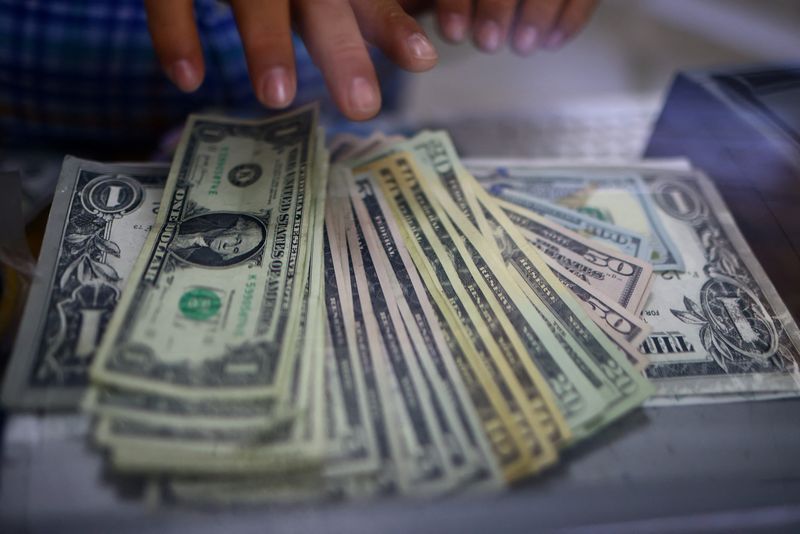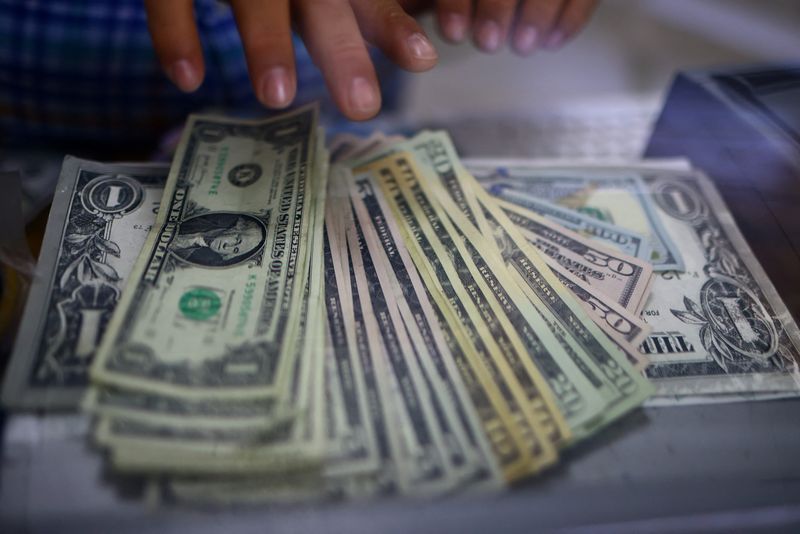
By Ankur Banerjee and Amanda Cooper
LONDON/SINGAPORE (Reuters) -The dollar hovered close to a two-week high on Tuesday as investors geared up for a slew of economic data, including Friday’s U.S. payrolls, that could influence the size of an expected interest rate cut from the Federal Reserve.
The yen, meanwhile, broke a four-day losing streak against the dollar after media reports cited the Bank of Japan governor reiterating in a document submitted to a government panel on Tuesday that the central bank would keep raising interest rates if the economy and inflation performed as policymakers currently expect.
Japan’s yen, which has staged a 10% rally in the last two months – aided in part by official intervention – gained, leaving the dollar down 0.7% at 145.815.
“The governor of the Bank of Japan wrote a letter to the Japanese government, explaining the decision to raise rates in July. He also said that the BOJ will continue to raise interest rates ‘if the economy and prices perform as expected’,” XTB research director Kathleen Brooks said.
“The yen is higher on the back of these comments,” she said.
The euro eased 0.13% to $1.1056, not far from Monday’s two-week low of $1.1042, while sterling eased 0.17% to $1.3124.
That left the dollar index, which measures the U.S. currency against six rivals, modestly in positive territory at 101.68, just shy of the two-week high of 101.79 it touched on Monday. The index fell 2.2% in August on expectations of U.S. rate cuts.
Investor focus this week will squarely be on the U.S. payrolls data due on Friday after Fed Chair Jerome Powell last month endorsed an imminent start to interest rate cuts in a nod to concern over a softening in the labour market.
Ahead of that, job openings data on Wednesday and the jobless claims report on Thursday will be in the spotlight.
Markets are pricing in a 69% chance of a 25 basis points (bps) cut when the Fed meets on Sept. 17 and 18, with a 31% probability of a 50-bps cut, CME FedWatch tool showed.
This week’s deluge of jobs data will be crucial in determining whether the Fed cuts by 25 or 50 basis points in September, said Charu Chanana, head of currency strategy at Saxo.
“If the data remains robust, a 25 bps cut is more likely. However, a weak non-farm payrolls, particularly if it falls below 130,000 with another jump higher in unemployment rate, could push the rates market closer to pricing a 50 bps cut.”
Economists surveyed by Reuters expect an increase of 165,000 U.S. jobs in August, up from a rise of 114,000 in July.
Data on Friday showed personal consumption expenditures (PCE) price index – Fed’s preferred measure of inflation – rose 0.2% in July, matching economists’ forecasts, keeping the U.S. central bank on the path to cut rates.
“We are in a Goldilocks moment right now and so we continue to believe the Fed will start cutting rates this month in a very gradual manner,” Win Thin, Brown Brothers Harriman’s global head of market strategy, said in a note.

Markets, though, anticipate 100 bps of cuts from the remaining three meetings this year.
With risk sentiment looking a little shaky, the Australian dollar was down 0.6% at $0.6749, while the New Zealand dollar slipped 0.61% to $0.6196, having surged 5% last month. [AUD/]
This post is originally published on INVESTING.



